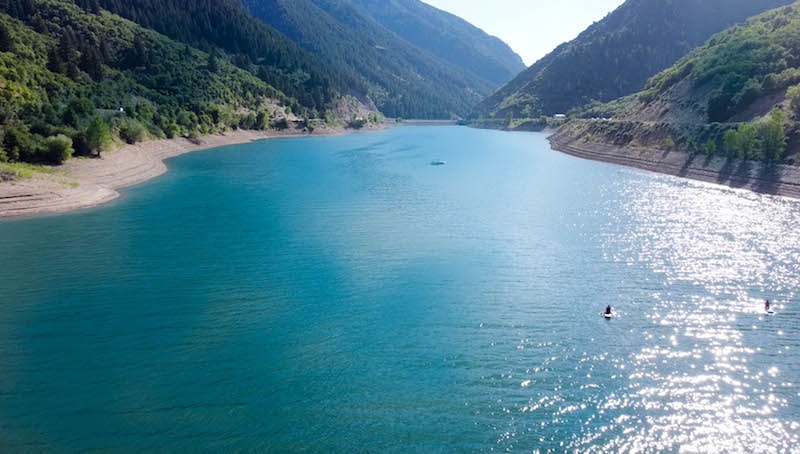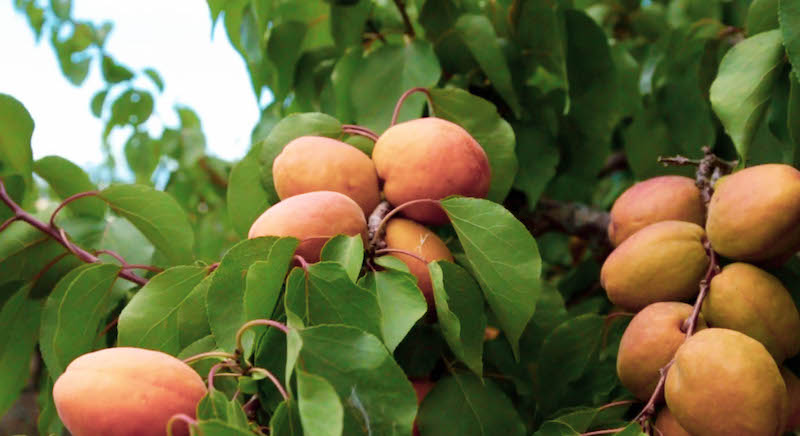
Paul Nielson is a fourth-generation farmer in Perry, Utah who has personally been at it for fifty years. “In all my years of farming it has never been this bad,” he observes. Nielson serves on the Weber-Box (Weber County/Box Elder Water Conservation Board of Directors, which controls the outflow of water from Pineview Reservoir. With Pineview being at its lowest level in years, some drastic measures need to take place. The Board has already sent a notice to the residents of Perry, who rely on Pineview water for their secondary water, that unless residents agree to major conservation efforts, their water might be shut off by August 1st.
Thayne Tagge also operates a farm in Perry that relies on Pineview water. He bought his first orchard in 1998, and says that when he purchased the property, the former owner laughingly said, “With this orchard, and this water, you will never have any worries over water.” But this year, Tagge says, “I’m worried.”

About eight years ago, Tagge began taking all of his orchards off of flood irrigation and switching to drip irrigation. The USDA offered farmers a grant to pay for the entire amount. Five years ago he was the only farmer in Perry to make the shift to drip, but today it’s about 75% of farmers. ‘It’s really great to see,” says Tagge.
Drip irrigation uses about 70% less water than flood irrigation, and allows farmers to save a huge amount of their water shares, so everyone is better off. But Tagge says that some farmers just don’t want to make the shift. Right next door to Tagge is runoff from the neighboring orchard, with water spilling over into Tagge’s parking lot and going down a drain. “It would take about one hour with a backhoe to fix that,” he says.
I followed Tagge around his farm sites in Perry for a couple of hours and he showed me how he operates his watering system. When it’s his turn with his 5/8ths acre foot from his Pineview water shares, he spends all day driving around examining his massive network of watering lines.

Above the town of Perry, along the benches is a concrete aqueduct, built in the late 1800s. On Mondays the Water Master turns a giant wheel that lowers a gate, allowing water to flow from the aqueduct down a channel which goes down a stay. The water is distributed to his four farm sites through pipes and a massive filtration system that he controls with an app on his phone.
“This Pineview water is so clean and so awesome most of the time. The crystal clear water is great this time of year, but,” Tagge says, “as the water level declines, the water will gain a greater concentration of silt. It makes things a little more difficult. But I feel so lucky to have such a great water source here.”
Tagge shows me all the measures he is taking to conserve water. He drives around on his four-wheeler and scans all of his irrigation hoses for leaks. A box fitted on the front of his four-wheeler has all the parts he needs to fix any problems. But he admits the water situation is extremely complicated. “It’s a different situation for everyone.”

Because you have the Bear River drainage, the Perry Canyon drainage, Willard Canyon drainage, Pineview water and so many irrigation ditches, even close neighbors could have completely different water situations. Perry City residents have both culinary water as well as Pineview pressurized water. But there is no metering on the Pineview water. This requires residents to operate on the honor system. The Perry City Newsletter has a list of requirements for residents to save water, including no watering on consecutive days, but seeing how Tagge’s neighbor is allowing hundreds of gallons of water to run off into a drain, it seems unlikely that everyone will comply with the mandates.
Nielson added, “This year, farmers don’t need to worry because we have priority with our water shares. Residents might have to cut way back, but they aren’t going to tell us we can’t water our crops…” But Nielson added a dire warning: “If next year it is as bad as this year, then we all need to worry about our farms.”
Tagge added to that sentiment. “The Governor is telling us to pray for rain. I think we are past that already. What we really all need to do is pray for snow come November through February. A huge snowpack is what makes all the difference.”
Subscribe to Utah Stories weekly newsletter and get our stories directly to your inbox





